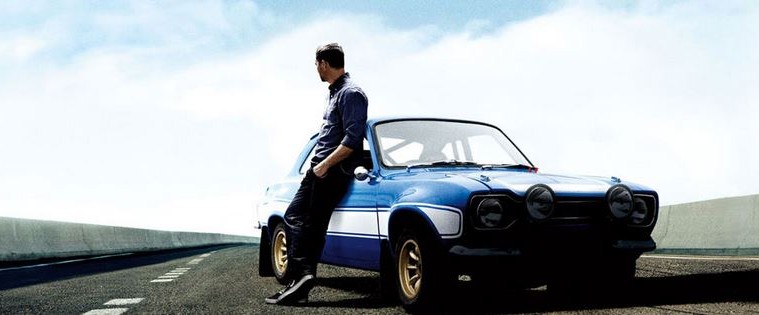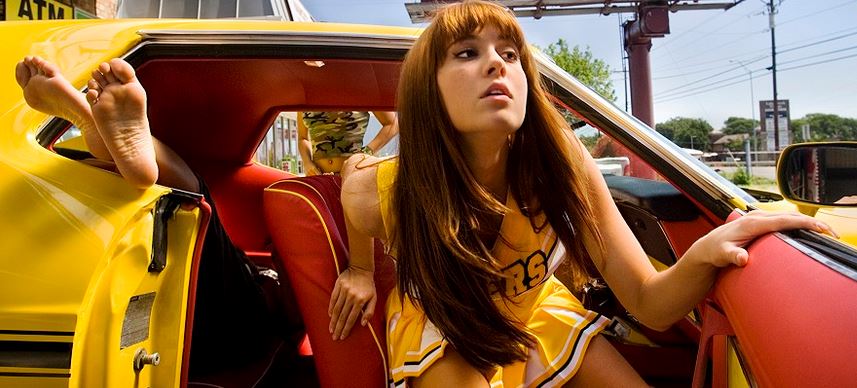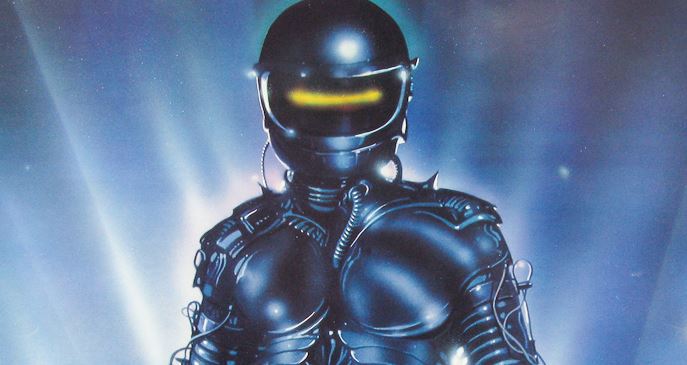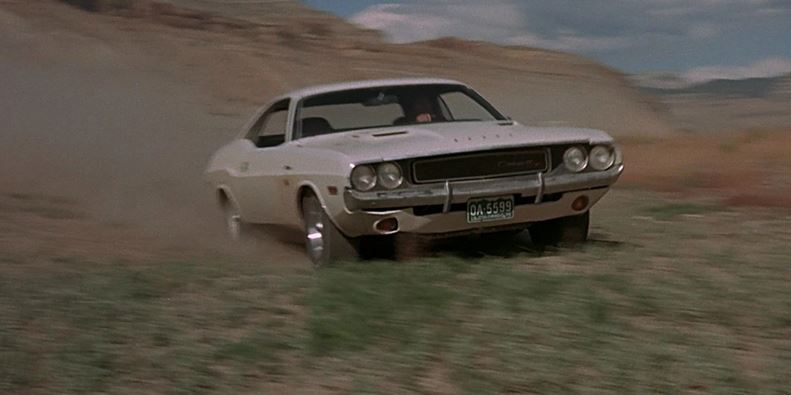Ride or die.
By The Action A Go Go Special Forces Unit
In case you didn’t know, Furious 7, the seventh film in The Fast And The Furious franchise, is about to drift into theaters, and we can’t help but be more than a little excited by the latest addition to the Toretto family tree.
We also can’t help but have cars on our mind this week. Particularly, cars on film.
Early this month I asked our writers to chime in on their favorite “car movies.” Deliberately, I left it open to interpretation to see how each person defines what a car movie means to him or her. The end result was an eclectic mix of cinematic classics with an unabashed need for speed and newer films that patiently build their stories around the moment when foot meets accelerator.
Read on…
-Troy
Troy’s Favorite Car Flick: Rush (2013)
While most car films focus squarely on the romantic nature of racing, Ron Howard’s Rush zeroes in on the methodology. In the process, we learn more about the personalities that get behind the wheel than you would normally find in a movie like this.
Based on the true life rivalry between Formula One racers James Hunt (played with winning self-assuredness by Chris Hemsworth) and Niki Lauda (a more-than-worthy Oscar-nominated performance by Daniel Brühl), Rush pits Lauda’s German pragmatism against Hunt’s daredevil antics. On the race track, despite their difference in philosophies, the two men are pretty evenly matched. Off the race track however, Hunt’s care-free attitude continues to cost him personally while Lauda’s obsessive compulsive behavior continues to cost him professionally.
Director Ron Howard (Apollo 13, A Beautiful Mind) is an ace at dramatizing real life scenarios suspensefully, and with Rush he uses those sensibilities to build an emotional character study just as breathless and high octane as The Fast and The Furious films.
From the rousing Hans Zimmer score to the recreation of Hunt and Lauda’s epic races to the death, if you’re not a fan of F-1 racing then Rush will turn you into one.
Derek’s Favorite Car Flick: Gumball Rally (1976)
This is the red-headed stepchild of Cannonball Run. It is the lesser known film of the two but the premise is the same: Let’s illegally race across the country at incredible speeds to prove who is the fastest.
That’s it.
The great Raul Julia and Gary Busey have roles in the film, but the cars are the real stars. Particularly, a legit Cobra 427 and Ferrari Daytona droptop. Fast, fun, and crazy, this is the type of movie that simply can’t get made anymore for all sorts of reasons. But it’s legacy lives on during the annual Gumball 3000.
Surprise! Rich people still do crazy things in fast cars. Go figure…
Andrew’s Favorite Car Flick: Death Proof (2007)
Death Proof is absolutely one of my favorite Quentin Tarantino films. Mainly because it strips his directorial style down to what he does best: dialogue and tone. All things considered, not much happens for long stretches of Death Proof, but the purpose of its pacing is two-fold:
First off, it’s something of a hang-out movie. It’s a masterpiece that you can just chill with on a Saturday night while hanging with friends and snacking on nachos or what have you.
Secondly, the relative slowness of the piece serves as beautiful misdirection. Because when things do happen, they come out of nowhere and the energy is electric.
But what separates Death Proof from the rest as a “great car movie” is how enthusiastically it wants the audience to engage with it about its central passion: cars. Unlike, say The Fast and the Furious movies where the car talk may as well be French, Death Proof allows the audience to enter into the movie’s own automobile fixation. And the result, especially for the car-illiterate (such as myself), is the gift of genuine appreciation for the vehicles and those who drive/love them. When watching Death Proof I get to be a “car person” for a whole two hours. And that’s the kind of immersive, transportational power that only the very best kind of filmmaking can offer.
Sy’s Favorite Car Flick: The Wraith (1986)
This b-movie is what High Plains Drifter would’ve turned out like had it been a ghost story that involved muscle cars.
The plot involves a murdered young man returning from the dead looking like an extraterrestrial armor-clad race-car driver with the coolest car ever, to boot. He drives an all-black super-charged Dodge “Turbo Interceptor” and takes revenge on the men who murdered him, a gang of punks (each with their own souped-up vehicle) who force innocent people into drag-races so they can obtain their cars.
The racing scenes between the gang and the Wraith, the deadly explosive outcomes and the musical backdrop of 80’s hard rock gives it an appeal to car buffs and fantasy lovers alike.
Tabatha’s Favorite Car Flick: Collateral (2004)
Your average movie hitman sports a luxury car to make his rounds, but this hitman (Tom Cruise) takes a cab.
While Vince, Tom Cruise’s character, made this film exciting, it is Jamie Foxx’s character Max, that keeps it grounded. Max’s character is a clear reminder that we’re all human with our own issues. He’s just a normal man that has potential to be more than a cab driver, but doesn’t pursue his dreams or try to really reach his potential. One night, he picks up a fare that takes him on an adventure of a lifetime, only he’s the one that has to transport them through it, or else.
Fox plays a very convincing “victim” and, at times, I wished that I was Max. To experience the adrenaline rush of “What if I do, what if I don’t” — the uncertainty of my fate when all is said and done. What would I do in his situation? Then I remember I don’t like to gamble and that I like to minimize risk. I snap back to reality and wipe the sweat off my brow.
Zak’s Favorite Car Flick: Vanishing Point (1971)
This tale of a tortured Vietnam vet who delivers cars across state lines is one of the best disillusionment films of a substantial crop in the late 60’s and early 70’s.
Kowalski (Barry Newman) bets a bag of speed that he can make it from Denver to San Francisco in half a day. The high speed it takes catches the attention of quite a few police officers and what follows are several chase sequences between Kowalski’s white Dodge Challenger and various other vehicles. Meanwhile, a blind disc jockey named Super Soul hears about the pursuit on the police band and uses his show to assist Kowalski and rally all the listeners to his anti-authoritarian stand.
This would make my favorite car movie if just for performance of Cleavon Little as the aforementioned Super Soul and a third act chase where a helicopter flies so close to the car it made my palms sweat. But the strong political sentiment and sumptuously photographed Southwest landscapes really make this a complete and artful action film.
Greg’s Favorite Car Flick: Ronin (1998)
There are great car movies, and more specifically great car chase movies, that fetishize the “tools” of the road. For action movies, if it is not a quick punch or an accurate gun, the next icon is the automobile – that instant, unmistakable life-changing invention that made transportation as personal and intimate as it is practical and fast (at least faster than a bike). With a car, a hero can now get to the fight quicker or at least “reach out and touch someone.”
There are hundreds of movies that come to mind when asked what is one’s favorite car chase film. It could be any from the 1960s and 1970s, the time period that made stuntmen gods. And even in the last 10-15 years, films like Death Proof and the Fast & Furious series have made the car as viable as it ever has been (along with keeping that age-old question alive: which is better, American Muscle or Import Speed?).
For me, when the question comes up, John Frankenheimer’s 1998 film, Ronin, instantly enters my mind. Not only was it a movie I saw in the “sponge years” of my teens, but it was also a solid action film starring my favorite actor at the time, Robert De Niro, in arguably one of the last roles where he gave a shit.
Little did I know at the time that Frankenheimer himself had cultural cachet with cinephiles. Somewhat an auteur, Frankenheimer had the reputation as a director of great films (The Train, The Manchurian Candidate) and sexy trash (52 Pick-Up, Reindeer Games), but maybe also the dubious distinction as a journeyman director, especially late in life. He was known as the guy the studios called in when someone screwed up, went over budget and over schedule — when a director was being a pain-in-the-ass, or an inexperienced producer made the project unsalvageable (for instance, The Island of Dr. Moreau). But, in the case of Ronin, the film feels like Frankenheimer turning in a love letter to France, something he definitely had an affinity for and cared about after having lived there for decades.
With a Dirty Dozen-like cast, including De Niro, Jean Reno, Stellan Skarsgard, Natascha McElhone, Skipp Sudduth, Sean Bean and Jonathan Pryce, Ronin always feels propelled forward. Built of experts in espionage, military tactics, assassination & heists and leaking an aura of the post-Cold War climate of Europe, the film is a stage for calculated plans and even more improvised action.
France is, in many ways, perfectly suited as the setting: Paris and Nice are two sides of the same coin – historic, sophisticated, urban class on one hand, and quaint, rich, rural escape on the other. Those winding roads are something to focus on, wedged between close buildings in the villages, opening to speedways in the countryside.
This is not the Autobahn though. Much like any vacation resort, the roads are meant for slow sightseeing and vespa rides. More apt are the tunnels, enclosed and twisting, the traffic circles and arched roadways. This is the sandbox you give a kid like Frankenheimer the toys to play with.
Let’s catch up to the car chase near the end of the film. Gregor (Skarsgard) has betrayed the group of mercs and has subsequently been kidnapped by IRA rogues. In pursuit is Sam (De Niro), supposedly former CIA, and Vincent (Reno), a French fixer of some sort. Spinning through city streets, scraping through tunnels, side-swiping other cars, shooting drivers, doing donuts, missing bystanders, and eventually throwing a car off the unfinished ramp of a highway.Whew!
What I love about Frankenheimer’s approach to action is that it is the exact antithesis of the Bourne-type action we have gotten throughout this last decade. There’s no shaky-cam here. Everything is precise and locked down. You can see everything! The action is built in the cutting room with inserts and multiple camera angles covering the heart-stomping speed of the chase. The wide angle lens (a Frankenheimer staple in actor close-ups and action) is the main star here. Attached to the hood of a hero car (the car being focused on) or the chase car (driven by stuntmen with camera crew), the camera always takes on an ethereal, floating, flying concept in capturing the speed of the movie in true, stretched widescreen. This film not only looks fast, it feels fast. And epic.
The chase is obviously the work of superb stunt drivers, and done all practical. It is kind of funny to see the inserts of De Niro, triple-chinned, trying to control the steering wheel while looking cool, calm, and collected. He does not. But the expertise comes across nonetheless, as alleyway cameras focus on the hoods of souped-up V6 engines and sleek sedans making hairpin turns and creating near-miss scenarios in confined corridors.
The sound design should not be glossed over either. I do not remember how much music there was, or if it existed at all as the engines, screeches and scraping metal took centerstage. It is a beautiful auditory soundscape, especially with the echoes and reverberations within the tunnels
It is this kind of car chase I am always looking for at the movies; putting fast cars on small roads that can hardly handle them. Nearly 20 years later, I have seen fantastic stunts, but none that have captured the practical stunt work of a bygone era. Even the chase films I admire these days all have a level of CGI injected into them. We need to get back to Dirty Mary, Crazy Larry, White Lightning, Mad Max, and…Ronin.
Action A Go Go on Twitter and Instagram |Be sure to leave your thoughts in the comments section!
Sprung from the mind of a mad man, built in seclusion, machined to exacting standards, and let loose upon the unsuspecting masses, ActionAGoGo.com rose up like a mighty beast to lay waste to all other websites that dare challenge it!








